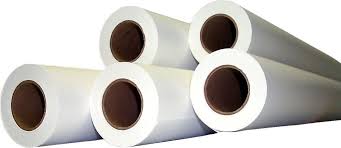As so many innovative products are, Tyvek was created by accident when a DuPont employee observed an unintended byproduct of a manufacturing process. That was 1955. It took 12 years to figure out how to initially commercialize the resulting product which we now know as Tyvek. Even if you’re not on a first name basis with the dozens of uses of Tyvek or its derivatives, there’s a good chance you come into contact with a few of them almost every day. The following discussion on colored Tyvek rolls and plotter paper focuses on two popular product uses.
What is Tyvek Anyway?#
Tyvek, in its various incarnations, has risen to a position of prominence as a paper substitute in industrial, office, and consumer settings. One of its earliest uses was by construction companies that used it to wrap and protect partially-finished houses from the elements. Thanks to its strength and resistance to bacteria, the medical industry jumped onboard in the early 1970s and put Tyvek to use as an equipment and pharmaceutical packaging material. This flashspun synthetic is difficult to tear but easy to cut, and can be printed on with great results. Though 8.5 x 11 inch sheets are widely available for use with home inkjet printers, larger rolls in a variety of colors are now widely marketed for a variety of uses.
Tyvek: the Paper that Isn’t#
Any time you hear the words “Tyvek paper,” you should be aware that the person really isn’t talking about paper in the traditional wood pulp sense. Tyvek Paper Rolls are a product derived from the original synthetic product. This new “paper” is thin, waterproof, and synthetic as well. The misleading nomenclature came about due to its similarity to paper in how it could be used, though its strength, light weight (lighter than actual paper even), and waterproofing characteristics make it a better material than paper in many instances.
Tyvek Paper Rolls are produced in a variety of colors but do suffer from a few limitations. The first is that the material is slick. Very slick. As such, any use which involves walking on it would probably be a bad idea, thanks to the chance of slips and falls. Also, and this might come into play more in an industrial or manufacturing setting, Tyvek paper can’t be used near high heat because it will melt and might even be a fire hazard.
Lastly, you can’t print on Tyvek paper. This limitation doesn’t extend to all Tyvek products. The original Tyvek material is excellent for printing, but the particular manufacturing process involved with Tyvek paper precludes any kind of printing. Who knows what the future may bring? Printing technology is moving forward all the time but for now, don’t try it. The results will be most unsatisfactory.
Tyvek as Plotter Paper#
The architectural and construction industries, in particular, have always had a need for oversized paper on which to render engineering or building designs created by computer-aided design (CAD) software. The hazards of standard or coated paper in these environments – often outdoors and exposed to rain and snow – is obvious.

Tyvek’s natural properties of being resistant to tears and completely waterproof offer a serious upgrade for field work in these two specific applications, though the use of Tyvek plotter paper goes well beyond the parameters of this article. Translucent overlays are a big part of design work and represent an area where traditional paper falls short on conveying a sense of the project as it comes together in stages.
The Bottom Line#
Today’s reality is that the various products and permutations that have arisen from the original product known as Tyvek have, to some extent, revolutionized various phases of industry, construction, and manufacturing. Colored Tyvek rolls and Tyvek paper are just a few of dozens of ways science has done its part to turn wood pulp paper into something of an anachronism



